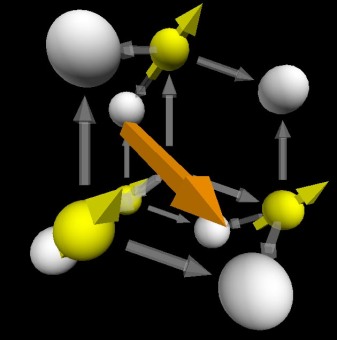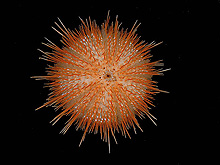Part Four of a Series on N=4 Super Yang-Mills Theory
This is the fourth in a series of articles that will explain N=4 super Yang-Mills theory. In this series I take that phrase apart bit by bit, explaining as I go. Because I’m perverse and out to confuse you, I started with the last bit here, and now I’ve reached the final part.
N=4 Super Yang-Mills Theory
Last time I explained supersymmetry as a relationship between two particles, one with spin X and the other with spin X-½. It’s actually a leeetle bit more complicated than that.
When a shape is symmetric, you can turn it around and it will look the same. When a theory is supersymmetric, you can “turn” it, moving from particles with spin X to particles of spin X-½, and the theory will look the same.
With a 2D shape, that’s the whole story. But if you have a symmetric 3D shape, you can turn it in two different directions, moving to different positions, and the shape will look the same either way. In supersymmetry, the number of different ways you can “turn” the theory and still have it look the same is called N.
Consider the example of super Yang-Mills. If we start out with a particle of spin 1 (a Yang-Mills field), N=1 supersymmetry says that there will also be a particle of spin ½, similar to the particles of everyday matter. But suppose that instead we had N=2 supersymmetry. You can move from the spin 1 particle to spin ½ in one direction, or in the other one, and just like regular symmetry moving in two different directions will get you to two different positions. That means you need two different spin ½ particles! Furthermore, you can also move in one direction, then in the other one: you go from spin 1 to spin ½, then down from spin ½ to spin 0. So our theory can’t just have spin 1 and spin ½, it has to have spin 0 particles as well!
You can keep increasing N, as long as you keep increasing the number and types of particles. Finally, at N=4, you’ve got the maximal set: one Yang-Mills field with spin 1, four different spin ½ spinors, and six different spin 0 scalars. The diagram below shows how the particles are related: you start in the center with a Yang-Mills field, and then travel in one of four directions to the spinors. Picking two of those directions, you travel further, to a scalar in between two spinors. Applying more supersymmetry just takes you back down: first to spin ½, then all the way back to spin 1.

N=4 super Yang-Mills is where the magic happens. Its high degree of symmetry gives it conformal invariance and dual conformal invariance, it has been observed to have maximal transcendentality and it may even be integrable. Any one of those statements could easily take a full blog post to explain. For now, trust me when I tell you that while N=4 super Yang-Mills may seem complicated, its symmetry means that deep down it is one of the easiest theories to work with, and in fact it might be the simplest non-gravity quantum field theory possible. That makes it an immensely important stepping stone, the first link to take us to a full understanding of particle physics.
One final note: you’re probably wondering why we stopped at N=4. At N=4 we have enough symmetry to go out from spin 1 to spin 0, and then back in to spin 1 again. Any more symmetry, and we need more space, which in this case means higher spin, which means we need to start talking about gravity. Supergravity takes us all the way up to N=8, and has its own delightful properties…but that’s a topic for another day.



I stumbled across your blog today (when I should have been coding…) and I must say that I’m impressed. It’s one of the most informative and entertaining physics blogs I’ve read.
I was wondering if you’d have any advice on how someone could get into this stuff?
(By that I mean in more than a superficial understanding kind of way)
I’ve just finished my undergrad in physics and I’ll be starting a PhD (in theoretical astro) soon, but wont have the same opportunities regarding taking postgraduate classes as people do in the USA. I’d be delighted if you could share some insight into where to begin?
LikeLike
It depends what you mean by getting into it, and how specific you mean by “this stuff”.
By “this stuff”, do you mean amplitudes and super Yang-Mills and that stuff, or just more general theoretical physics? And by getting into it, do you mean starting a career in it (in which case theoretical astro is sort of to the side, depending on what you mean by “this stuff”), understanding it well enough to be able to read papers, or just understanding it above the Brian Greene level?
LikeLike
Hi , I too want to seriously study N=4 SUSY to the point of doing actual research. I have a background in N=1 SUSY in 4 dimensions. I would like to ask for your recommendations
LikeLike
You explained SYM very easily.
LikeLike
Thank you for this incredible article! Loved it! Really helped me with all the supersymmetry nuts and bolts!
LikeLike
How is spin still conserved? I’m picturing a vertex in a Feynman diagram where a spin-1 particle interacts with two spin-1/2 particles (e.g. an electron absorbing a photon). Now I apply one dimension of supersymmetry and I should still get physics that makes sense, right? Isn’t that how this kind of stuff works? But now I get a spin-1/2 particle interacting with two spin-0 particles, and that can’t conserve spin. Is that not how these symmetries work? Do each of those particles have to follow a different “direction” of supersymmetry when I transform them or something?
LikeLike
When I said “supersymmetric partners have the same interactions” I was speaking somewhat loosely, and it ended up being misleading. Supersymmetric partners have the same charges, but they don’t have the same interaction vertices. For example, four gluons can interact in N=4 super Yang-Mills, but there aren’t direct interactions between four fermions. Basically, when supersymmetry has you replace a particle with one of a different spin, it’s replaced in a particular combination, and some of those combinations end up vanishing. This is part of how in realistic supersymmetry models you can have superpartners with different mass: supersymmetry gets broken in part because the different particles are interacting with some other field in different ways.
LikeLike
I see. Thanks!
LikeLike